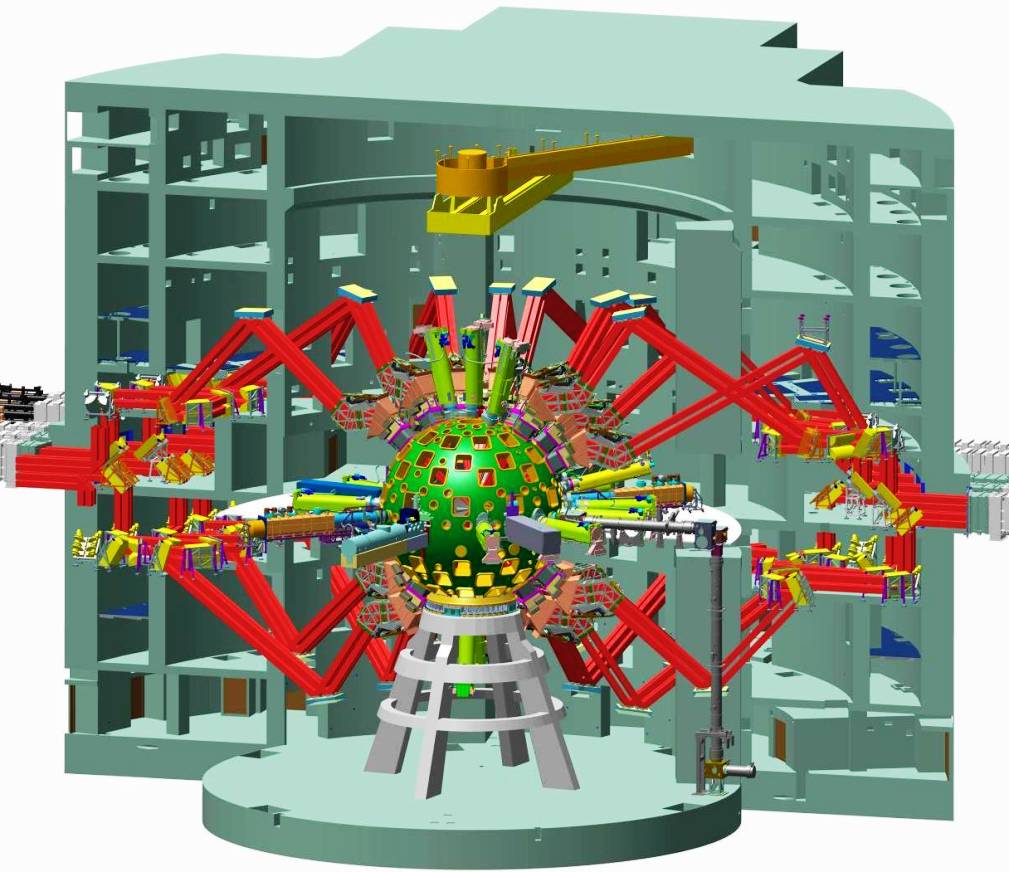Rationale
The Laser Megajoule (LMJ) is part of the “Simulation Program” developed by the CEA-DAM. The Simulation program aims to improve the theoretical models and data used in various domains of physics, by means of high performance numerical simulations and experimental validations with the help of big facilities like LMJ.
LMJ offers unique capabilities for the Simulation Program, providing an extraordinary instrument to study High Energy Density Physics (HEDP) and Basic Science.
A large panel of experiments can be done on LMJ to study physical processes under extreme conditions, with temperatures from 100 eV to 100 keV, and pressures from 1 Mbar to 100 Gbar.
Laser characteristics
LMJ is a flash-lamp-pumped neodymium-doped glass laser (1.053 µm wavelength) configured in a multi-pass power amplifier system.
The 1.053 μm light is frequency converted to the third harmonic (0.351 μm) and focused, by means of gratings, on a target at the center of the target chamber.
When completed, LMJ will deliver shaped pulses with adjustable duration from 0.7 ns to 25 ns with a maximum energy of 1.3 MJ and a maximum power of 400 TW of UV light on the target.

The main building includes four similar laser bays, 130-meter long, situated in pairs on each side of the central target bay of 60-meter diameter and 40-meter height.
The 176 square 37 x 36 cm2 laser beams are grouped into 22 bundles of 8 beams in the amplification section.
In the switchyards, each individual bundle is divided into two quads of 4 laser beams, which are directed to the upper and lower hemispheres of the chamber.
A quad is the basic independent unit for the irradiation geometry of experiments.
The 44 quads enter the target chamber through laser beam ports which include the final optics assembly: vacuum windows, debris shields and device to check the damages on optics.

Target chamber and irradiation
At the center of the target bay, the target chamber consists of a 10-meter diameter aluminum sphere, equipped with two hundred ports for the injection of the laser beams, the location of diagnostics and target holders. It is a 10 cm-thick aluminum sphere covered with a neutron shielding made of 40 cm thick borated concrete.

LMJ is configured to operate in the “indirect drive” scheme, which drives the laser beams into cones in the upper and lower hemispheres of the target chamber.
Two times twenty quads enter the target chamber through ports that are located on two cones at 33° and 49° polar angles. Two times two other quads enter the target chamber at 59° polar angle, and are dedicated to radiographic purpose.

Plasma diagnostics
Over 30 plasma diagnostics are considered on LMJ with high spatial, temporal and spectral resolution in the optical, X-ray, and nuclear domains.

18 diagnostics will be available in 2024 :
- seven X-ray imaging systems with a 15 to 150 μm spatial resolution and a 30 to 120 ps time resolution, providing over 40 imaging channels,
- two absolutely calibrated broadband X-ray spectrometers (30 eV – 20 keV),
- a time resolved high resolution X-ray spectrometer (1 – 15 keV),
- a time integrated hard X-ray spectrometer (6 – 100 keV)*,
- an optical diagnostic set dedicated to “Equation of State” measurements including :
- 2 VISAR (Velocity Interferometer System for Any Reflector),
- 2 SBO (Shock Break Out),
- a pyrometer
- a reflectivity measurement,
- two diagnostics analyzing the backscattered light to determine the laser energy balance,
- two electron spectrometers (5 – 150 MeV)*,
- a charged particles spectrometer for electrons and ions (0.1 – 200 MeV) *
- an imaging module for proton-radiography,
- a neutron pack, to measure neutron yield, ion temperature and neutron bang time.
*These specific diagnostics adapted to PETAL have been developed in the framework of the PETAL+ project, an Equipex project of the University of Bordeaux funded by the ANR (French National Research Agency).

Chronicle
The LMJ building construction started in 2003, and the commissioning happened five years later.
The first CEA-DAM physics experiments on LMJ have been performed in October 2014 with a limited number of beams and diagnostics. The operational capabilities (number of beams and plasma diagnostics) are increasing gradually every year until the completion of the facility.
The first academic experiments on LMJ-PETAL have been performed in 2017 with 4 quads and the PETAL beam.
In October 2019 a first implosion of D2 filled capsule was achieved with 12 quads, leading to the first fusion neutrons production.
| Events | Date |
| Beginning of the construction of the LMJ facility | 2003 |
| LMJ target chamber installed | 2006 |
| LMJ building commissioning | 2008 |
| First target physics experiments on LMJ with 2 quads | 2014 |
| First associated LMJ and PETAL shot | 2015 |
| First academic experiments on LMJ with 4 quads and PETAL | 2017 |
| First production of D2 fusion neutrons on LMJ with 12 quads | 2019 |
More information is available in the User-guide and on the LMJ website :
– LMJ description (French) : http://www-lmj.cea.fr/lmj-description.html
– Diagnostics description (English): http://www-lmj.cea.fr/LMJ-PETAL-User-Group.html
